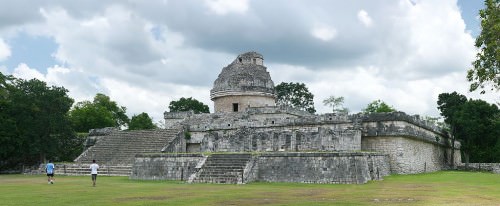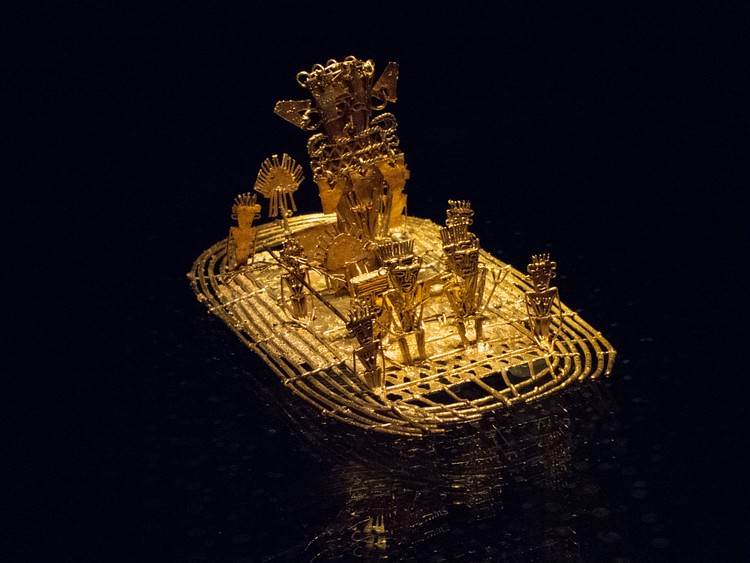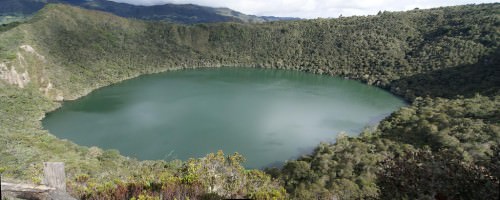Tlahuizcalpantecuhtli › El Dorado » Ancient origins
Articles and Definitions › Contents
- Tlahuizcalpantecuhtli › Who Was
- El Dorado › Antique Origins
Ancient civilizations › Historical and archaeological sites
Tlahuizcalpantecuhtli › Who Was
Definition and Origins

Tlahuizcalpantecuhtli, 'Dawn Lord,' was a Mesoamerican god who represented a menacing aspect of Venus, the morning star, and was one of the four gods which held up the sky. The people of the ancient Americas believed his rays could damage people, crops, and water sources. Tlahuizcalpantecuhtli played a key role in the Aztec creation myth and was 12th of the 13 Lords of the Day in the Aztec calendar.
VENUS, THE MORNING STAR
Tlahuizcalpantecuhtli (also spelt Tlauixcalpantecuhtli) represented the dual aspect of the planet Venus, known to the Mesoamericans as a bright star. Venus was especially important in the religious and agricultural calendar with its average 584-day cycle being carefully observed and precisely calculated. Even the architectural layout of cities, notably at Teotihuacan, Toltec Tollan, Maya Uxmal, and Chichen Itza, were built and aligned in accordance with the appearance of Venus at particular moments during its cycle. Mesoamerican astronomers recorded that the planet appears for 236 days as the morning star in the east, then sinks below the horizon for 90 days, and reappears for 250 days as the evening star in the west before disappearing again for 8 days before restarting the cycle over again. In actual fact, Venus can be seen with the naked eye for approximately 263 days in each spell, and it is not known quite why or how the ancient astronomers had arrived at their particular calculations.
Each aspect of Venus - morning and evening - was manifested in the form of two ancient Mesoamerican gods: the feathered-serpent Quetzalcoatl and his canine companion Xolotl. Quetzalcoatl represented Venus as the morning star, and Xolotl represented it as the evening star. In typical Mesoamerican duality, Tlahuizcalpantecuhtli was imagined as both and as the twin brother of Xolotl, and thus, above all, he represented the morning star aspect of Venus, which was considered a menacing one. Mesoamerican peoples considered the morning star particularly dangerous when it first appeared above the horizon each year (its heliacal rising). The rays, imagined in the form of atl-atl darts, were thought harmful to certain classes of people and to have a negative effect on maize and water.
FOR ANCIENT MESOAMERICANS, TLAHUIZCALPANTECUHTLI WAS ONE OF THE FOUR SKYBEARERS, THE GODS WHO HELD UP THE SKY.
THE SKYBEARER
For ancient Mesoamericans, Tlahuizcalpantecuhtli was one of the four Skybearers, the gods who held up the sky.Tlahuizcalpantecuhtli was, thus, associated with the direction East and the year date Acatl. The Skybearers may have helped the cosmos by holding it up, but they had another, less charitable aspect during eclipses and the Aztec New Fire ceremony to renew the sun each 52 years. Then they joined the Tzitzimime, star demons which could descend, eat up humanity and destroy the world if the sun did not return.
THE AZTEC CREATION MYTH
In the Aztec creation myth Tlahuizcalpantecuhtli, both as himself and as an avatar of Quetzalcoatl, plays a crucial role. When the twin brothers Nanahuatzin and Tecuciztecatl sacrificed themselves at Teotihuacan to create the sun and moon of the 5th and last epoch of the Aztec cosmos they needed something or someone to kick-start themselves into motion and set off on their respective orbits. Nanahuatizin called for a blood sacrifice, but Tlahuizcalpantecuhtli was having none of it and, instead, threw an atl-atl dart at the sun. The throw missed, and Nanahuatzin returned the favour with more accuracy, striking Tlahuizcalpantecuhtli smack on the forehead, instantly turning him into stone. In this state, he is known as Itztlacoliuhqui, the god of cold, snow, and ice. The rest of the gods saw that only a sacrifice would set the sun and moon in motion, and so Quetzalcoatl removed their hearts for that purpose. The offering worked, and the 5th and final cosmos began.

The Caracol, Chichen Itza
ART & ARCHITECTURE
Venus was often symbolised by a skull, and so too, representations of Tlahuizcalpantecuhtli depict him as a feathered serpent with a skull face. As the god was also closely associated with Mixcoatl, he sometimes wears the markings of that star god – white spots around a black field. Tlahuizcalpantecuhtli usually has five white spots representing stars, one on each cheek, and one on his forehead, nose and chin. One of the earliest examples of Tlahuizcalpantecuhtli in art is a rock painting at Ixtapantongo from around the 10th century CE.
Besides influencing the general town planning of many Mesoamerican cities, several specific buildings were aligned to the rise of Venus. Notable amongst these is the 24-room House of the Governors at Uxmal, constructed in the 10th century CE.Perhaps the most famous of all is the Caracol astronomical observatory at Chichen Itza which was constructed c. 800 CE.
El Dorado › Antique Origins
Definition and Origins

El Dorado ('Gilded Man' or 'Golden One') referred to the legendary kings of the Muisca (or Chibcha ) people who populated the northern Andes of modern-day Colombia from 600 CE to 1600 CE and the name is especially associated with their coronation ritual held at Lake Guatavita, just north of modern-day Bogotá. Over time, El Dorado extended its meaning to refer to a lost golden city and even an entire region. When the Spanish Conquistadors heard these incredible tales of a city paved in gold they tried every means possible to find it. Ultimately though, the Spanish, and the explorers and treasure hunters who followed them, never did find the fabulous treasures of El Dorado.
THE SIGNIFICANCE OF GOLD
In the cultures of ancient Colombia gold had long been a popular material for metalworkers. The metal actually had no particular value as currency other than as a raw material for exchange and, indeed, it seems that, unlike in other Americas cultures, gold was not limited to the nobility but also owned by lower stratas of society. Rather than its intrinsic value, then, gold was esteemed because of its lustre, incorruptibility, spiritual associations (especially concerning the sun), and workability in the hands of craftsmen. Skilled Muisca artisans produced stunning works of art using the full range of the goldsmith's repertoire, especially the lost-wax technique.
Gold and gold alloy artworks were offered in vast quantities to the gods and buried at sacred locations so that the balance of the cosmos was maintained and natural disasters averted. Very often the offerings were figurines known as tunjos which represented in fine detail people carrying objects such as shields, weapons and musical instruments. The most famous example of a tunjo is a golden raft with cast figures wearing jewellery standing upon it, the significance of which is discussed below. The raft was found in a clay vessel inside a cave and it now resides in the Museo del Oro in Bogotá.
THE MUISCA ESTEEMED GOLD BECAUSE OF ITS LUSTRE, INCORRUPTIBILITY AND ASSOCIATION WITH THE SUN.
So driven were they by their thirst for riches, the official Spanish government objective of exploration in northern South America was, in fact, to find gold, melt it down and ship as large a quantity as possible back to Europe. The association between ancient Colombia and the precious metal is further reflected in the Spanish King's choice of name for his new territory: Castillo del Oro. Of all the stories of gold and emeralds scattered across ancient Colombia there was one particular tale which especially aroused the interest of the Spanish invaders. This was an account, reported by eye-witnesses, which involved the lavish ceremonies performed during the coronation of a Muisca king.
THE GILDED MAN
The legend of El Dorado appears in most Spanish accounts of the region's conquest such as Fernández de Oviedo's Historia general y natural de las Indias (1535-48 CE) but was later documented in greatest detail by Juan Rodriguez Freyle in 1636 CE, who claimed to have been told the details by the nephew of the last ruler of Guatavita. One of the oldest representations of the legend in art comes from an engraving of 1599 CE by Theodor de Bry which shows two attendants applying gold to the body of a third individual.

Lake Guatavita, Colombia
According to the legend, then, amongst the Muisca, when it was necessary to crown a new monarch, the man who would be king prepared for his great day with a period of abstinence. Secluded in a cave, he was forbidden chilli peppers, salt and women. When the coronation day finally arrived the future king travelled to Lake Guatavita, a remote lake formed in an extinct volcanic crater, in order to give offerings to the gods so that they might bless his reign. This he did by going to the centre of the lake on a raft. The raft, made from reeds, was laden with treasures of gold and emeralds and on it were placed four large incense burners. The incense was moque and the braziers, joined by those set around the shores of the lake, gave off clouds of thick smoke which must only have added to the mystique of the ceremony.
The most fantastic treasure of all, though, was the royal person himself. He had been stripped naked and entirely covered in a sticky layer of resin on which was blown fine gold dust. The result was a sparkling man of gold; literally a 'gilded man'. Also travelling on the raft were four attendants, less spectacularly attired but still weighed down with heavy gold jewellery on any part of the body it could be hung from. The great moment came when, accompanied by mass trumpets and singing from the shores, the raft arrived in the very centre of the lake. At that moment silence fell on the crowd and the attendants threw the fabulous treasure of gold and jewels into the lake and the people on the shores also threw their golden offerings into the sacred waters. The climax of the ceremony came when the golden king himself leapt into the lake and when he emerged, cleaned of gold, he had become the king of the Muisca.
LATER HISTORY
From Sir Walter Raleigh to 20th century explorers, extravagant and costly expeditions to find El Dorado and its riches have been mounted over the centuries but none have had success. In the 1580s CE Antonio de Sepúlveda had perhaps the most ambitious scheme to find the gold when he cut a slice out of Lake Guatavita's crater edge in order to drain the lake and find the treasure which must have accumulated on the lake bed from centuries of coronation ceremonies. Some gold artefacts were found around the edges of the lake but before the lake could drain completely a landslide blocked the cut and so the water level of the lake began to rise again. Faced with a mutiny from the local population, the Spanish were forced to give up their search.
Another ambitous expedition in 1909 CE involved the English company Contractor Limited. They too sought to drain the lake and they were more successful than the Spanish. The method this time was to dig a tunnel under the lake and drain it that way. However, when the lake was emptied another problem arose and this was that the soft mud bottom of the crater was too deep to support any weight. Even worse, the mud quickly baked in the sun and became cement hard. Returning to Bogotá for drilling equipment the treasure hunters must have been crestfallen when they got back to the lake because in their absence the mud had also solidified in the drainage tunnel, blocking it so that the lake had filled back up again. With no more money to continue the project the English, like the Spanish and countless others before them, were forced to abandon the project with only a handful of small artefacts taken from the edge of the lake.
The cummulative results, then, of these expeditions have been hugely dissapointing. Some gold has been found, as too have stone beads and pottery, but nothing, so far, to match the fabulous riches described in the legend of El Dorado. Perhaps, though, this is fitting as, after all, the original owners of the gold and jewels had intended their offerings for the sun and for them to remain for all time where they were given, at the bottom of a lake in the remote mountains of Colombia.
LICENSE:
Article based on information obtained from these sources:with permission from the Website Ancient History Encyclopedia
Content is available under License Creative Commons: Attribution-NonCommercial-ShareAlike 3.0 Unported. CC-BY-NC-SA License